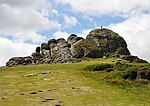River Lemon

The River Lemon is a 9.9 miles (15.9 kilometres) river in the county of Devon in southwest England. It is a tributary of the River Teign, starting on Dartmoor by Haytor, and ending in Newton Abbot. It rises on the south-east side of Dartmoor near Haytor, joins with the River Sig and the Langworthy Brook at Sigford, then passes the village of Bickington. Lower down, it is joined by the Kestor Brook and it then flows through the woods in Bradley Valley, past the manor house of Bradley, and through the town of Newton Abbot where it flows through a 440-yard-long (400 m) tunnel below the town centre. Just below the town, the river joins the River Teign at 50.517°N 3.607°W / 50.517; -3.607, near the head of its estuary. A considerable length of the River is designated as a Special Area of Conservation - The South Hams SAC for the Greater Horseshoe Bat, as protected flight corridors (this area extends 500 m each side of the River). The name Lemon is a derivative of a Celtic word meaning elm.
Excerpt from the Wikipedia article River Lemon (License: CC BY-SA 3.0, Authors, Images).River Lemon
Miles Without Stiles Haytor Quarry, Teignbridge Ilsington
Geographical coordinates (GPS) Address Nearby Places Show on map
Geographical coordinates (GPS)
| Latitude | Longitude |
|---|---|
| N 50.5832 ° | E -3.7534 ° |
Address
Miles Without Stiles Haytor Quarry
Miles Without Stiles Haytor Quarry
TQ13 9XT Teignbridge, Ilsington
England, United Kingdom
Open on Google Maps









